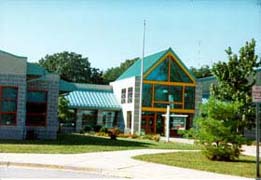 In Maryland, public education is a responsibility shared by State, county and Baltimore City government. The State Board of Education sets educational standards, certifies teachers, partially funds school construction and instruction, and monitors school performance. The Board also oversees the State Department of Education. County boards of education often set additional requirements, develop new programs, and provide substantial local funding. Local, State and federal funds combined to provide $7.7 billion for Maryland public schools in the 2003-04 school year. The average cost per pupil was $8,763 in the 2002-03 school year.
In Maryland, public education is a responsibility shared by State, county and Baltimore City government. The State Board of Education sets educational standards, certifies teachers, partially funds school construction and instruction, and monitors school performance. The Board also oversees the State Department of Education. County boards of education often set additional requirements, develop new programs, and provide substantial local funding. Local, State and federal funds combined to provide $7.7 billion for Maryland public schools in the 2003-04 school year. The average cost per pupil was $8,763 in the 2002-03 school year.
Solley Elementary School, Solley Road, Pasadena, Maryland, October 2000. Photo by Diane F. Evartt.
![[photo, Prince George's County Board of Education Building, 14201 School Lane, Upper Marlboro, Maryland]](/msa/mdmanual/36loc/pg/images/1198-1-933.jpg) On national tests, Maryland students consistently excel. Some 68 percent of Maryland public high school students took the Scholastic Assessment Test (SAT) in 2003, a high participation rate. In Advanced Placement courses, Maryland ranks second in the nation in the percentage of high school students scoring at the mastery levels.
On national tests, Maryland students consistently excel. Some 68 percent of Maryland public high school students took the Scholastic Assessment Test (SAT) in 2003, a high participation rate. In Advanced Placement courses, Maryland ranks second in the nation in the percentage of high school students scoring at the mastery levels.
Prince George's County Board of Education Building, 14201 School Lane, Upper Marlboro, Maryland, October 2004. Photo by Diane F. Evartt.
In September 2003, for prekindergarten through high school, 869,113 students enrolled in 1,409 public schools, and 186,407 students enrolled at 1,165 private schools. Public high schools graduated 54,999 students in 2004. Those intending to continue their education: 84.9% (80.4% in a college or university, 4.5% in a trade or business school); to work: 16.5%; to enter military service: 4%.
More stringent requirements for graduation from high school were set by the State in 1992. Credits required were increased from 20 to 21. General requirements were replaced with particular courses, or courses with specific content. Fewer credits were reserved for electives (nonrequired courses chosen by students). Students must pass functional tests in reading, writing, mathematics, and citizenship. They also must perform 75 hours of volunteer community service approved by the State.
Special Public School Programs. These cover prekindergarten for four-year olds; and career and technology education, including consumer and homemaking classes. Gifted and talented programs also are offered by the State, on a tuition basis, at summer centers for students who qualify academically, meet geographical distribution requirements, and are able to pay the cost.
Special education services for students with disabilities range from aid for part or all of a school day to specialized services for homebound students or those in separate facilities or hospitals. Within the State Department of Education, the Division of Special Education and Early Intervention Services administers both State and federal programs for special education.
© Copyright Maryland State Archives